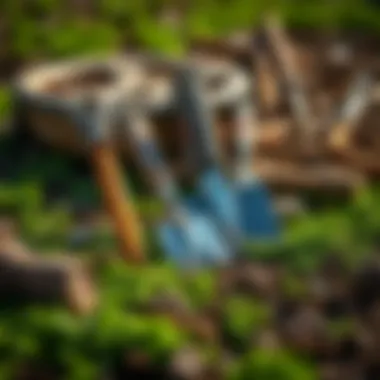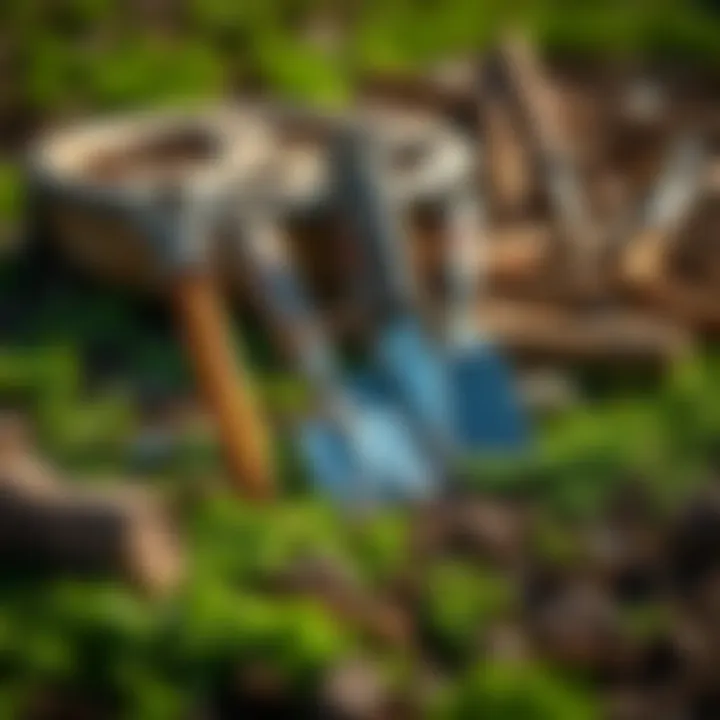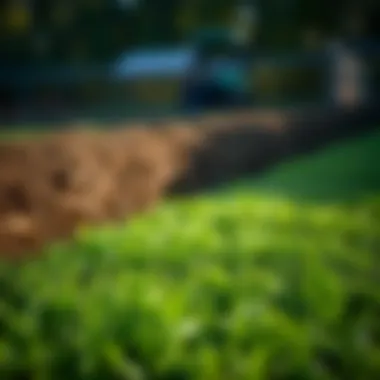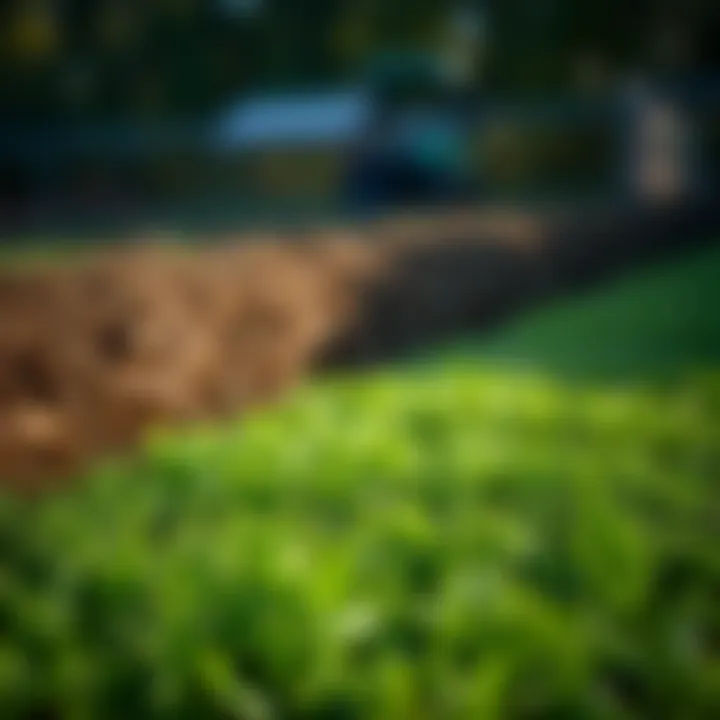Marathon Sod Installation: Tips and Best Practices


Intro
When it comes to creating a lush and vibrant lawn, marathon sod stands out as an excellent option for farmers and landscape enthusiasts alike. Unlike traditional seed-based methods, sod installation can offer an almost instant green landscape, making it ideal for both residential and commercial projects. However, diving into the world of sod is not as simple as rolling it out over the ground. It requires a well-thought-out approach that includes not only the installation technique but also considerations about soil compatibility, climate, and ongoing maintenance that will keep the grass thriving.
In this article, we’ll explore the nuances of marathon sod installation, providing a comprehensive guide that discusses essential techniques, critical considerations, and best practices. The aim is to arm gardeners and agricultural professionals with the necessary insight to ensure success in cultivating healthy and beautiful landscapes.
Key Concepts and Terminology
Understanding the key terms associated with marathon sod installation sets a solid groundwork for discussing the topic more deeply.
- Sod Quality: Refers to the health and viability of the grass before installation. Quality sod should be free of pests, diseases, and have a robust root system.
- Soil Preparation: This step involves analyzing and modifying the soil to create a conducive environment for the sod to thrive, including testing pH levels and amending with compost or fertilizers as necessary.
- Sod Installation: This is the physical process of laying down sod rolls on prepared soil—often done in a staggered pattern to prevent seams from aligning, which can lead to weak spots.
- Establishment Period: The time frame it takes for sod to root into the soil. Usually, this process can take anywhere from two to four weeks, depending on various factors.
Current Trends and Innovations
As more people lean towards sustainable practices, marathon sod is no exception to the innovations that are reshaping landscape design.
- Latest Research and Developments: New research continues to highlight the benefits of different varieties of grass, focusing on drought resistance and pest management. Understanding these advancements can enhance selection, ensuring that farmers choose the right variety for their local conditions.
- Emerging Technologies and Tools: The introduction of precision farming tools allows for better soil testing and moisture monitoring, which can significantly improve sod installation outcomes. For instance, soil moisture sensors help determine the optimal time for irrigation post-installation.
Practical Applications
Successfully installing marathon sod doesn't stop at simply laying it down. Here’s a structured approach to implementing best practices:
- Prepare the Soil
a. Clear the area of debris and weeds.
b. Test the soil to check pH and nutrient levels.
c. Amend the soil with organic materials to improve its structure. - Lay the Sod
- Ongoing Maintenance
- Begin laying sod at the edges of the area, working your way inward, making sure to stagger the seams.
- Water the sod immediately after installation to help with settling.
- Regular watering is crucial especially during the first few weeks.
- Maintain a proper mowing height—keep the blades sharp and avoid cutting more than a third of the grass blade at once.
"Creating a healthy lawn is like raising a child; it requires continuous love, care, and the right guidance to flourish."
Troubleshooting Common Issues
Common problems could arise during and after installation. Here are some frequently encountered challenges:
- Uneven Growth: Check soil level and consistency in watering during the establishment period.
- Pest Infestations: Regular inspection during maintenance can help catch pests early, allowing for prompt treatment before they cause significant damage.
By grasping these concepts and best practices, agricultural partners and gardening aficionados can effectively navigate the complexities of marathon sod installation, leading to healthy grass and a beautiful landscape.
Understanding Marathon Sod
Marathon sod is a grass variety that stands out for its ability to adapt and thrive under various conditions. This section discusses its characteristics and benefits, which are crucial for anyone considering sod installation or interested in lawn maintenance. Knowing what makes Marathon sod unique helps in making informed choices when landscaping or caring for your yard.
Definition and Characteristics
Marathon sod, commonly a blend of different grass types, is bred specifically for its resilience, lush appearance, and adaptability. It typically features a fine to medium texture, giving it a visually appealing look that many homeowners crave. This variety is particularly noted for its deep root systems, which enhance drought resistance and the ability to retain moisture. Its dark green color creates an inviting landscape, giving an aesthetic punch to any property.
Moreover, the sod's growth rate and density contribute to a thicker lawn, which can help prevent weed growth. In general, a good understanding of these characteristics sets the stage for knowing how to properly install and maintain a healthy lawn.
Benefits of Marathon Sod
The decision to choose Marathon sod over other varieties can be attributed to several factors that align with contemporary landscaping needs.
Resilience to Drought
One of the most notable benefits of Marathon sod is its resilience to drought. This characteristic ensures that it can endure dry spells without withering away. Because of its deep roots, this sod can reach water stored deeper in the ground, allowing it to survive longer periods without regular irrigation. This means less stress on both the environment and your water bills.
Furthermore, the drought tolerance contributes to less overall maintenance, as you won't have to worry about constant watering, especially during hot summer months. This adaptability makes it a practical choice for regions with erratic rainfall patterns.
Low Maintenance Requirements
Marathon sod is equally admired for its low maintenance requirements. Once established, it does not demand frequent mowing, fertilization, or watering. This is a significant advantage for busy homeowners and landscapers looking to reduce time spent on lawn care.
The grass's ability to resist pests and diseases further enhances its low-care appeal. Even if you notice some issues, the sod is forgiving and often bounces back with just minimal intervention. This minimizes the use of chemicals, making it a more eco-friendly option compared to other grass species that require regular treatments.
Rapid Establishment
Lastly, Marathon sod boasts rapid establishment, which means it can quickly take root and integrate into your landscape. This rapid growth not only allows for a lush lawn in a shorter timeframe but also means that homeowners can enjoy the aesthetic of a well-formed yard sooner.
The sod's robust nature means it can quickly adapt to various soil types and environmental conditions, reducing the risk of failure during the installation process. This speed of establishment presents a significant advantage for those who might be eager to have a lush lawn without the waiting game typical of other grass types.
"Choosing the right sod variety can make the difference between a thriving lawn and a patchy disappointment. Marathon sod covers more bases than some others in terms of resilience, maintenance, and establishment."
In summary, understanding Marathon sod isn’t just beneficial for making initial installation decisions; it provides a solid foundation for ongoing care and maintenance, ultimately leading to a thriving landscape.


Preparation for Installation
Proper sod installation is a job that doesn’t just involve laying down grass; it requires careful prep work. Without a solid foundation, the sod may struggle to thrive, leaving you with a less than ideal lawn. This preparatory phase lays the groundwork for success, making it crucial to understand the workings of site assessment and ground preparation.
Site Assessment
Soil Testing
Soil testing is often an overlooked step in the installation process that can make or break your sod's success. Essentially, it involves analyzing the soil's composition and nutrient levels. This testing can reveal the pH levels, nutrient deficiencies, and potential contaminations. A primary characteristic of soil testing is its ability to provide a scientific basis for amending the soil accordingly. By pinpointing precisely what your soil lacks, you can take targeted action.
The big draw here is that it allows you to optimize growing conditions for your new sod. If the soil testing reveals that the pH level is too acidic or alkaline, you might need to add lime or sulfur to adjust these levels. The unique feature of soil testing is that it gives you tailored insights—it's not a one-size-fits-all solution. However, it can be somewhat time-consuming and may require some investment into testing kits or laboratory services. Still, the benefits far outweigh these inconveniences, paving the way for a healthier sod.
Sunlight and Drainage Considerations
Sunlight and drainage are the twin pillars of a healthy sod installation. The grass needs adequate sunlight to photosynthesize and grow while good drainage prevents waterlogging, which can lead to root rot. The key characteristic here is to assess how much sunlight a specific area receives throughout the day. This is especially crucial if you're planting in an area shaded by trees or buildings.
Successful sod installation hinges on understanding these conditions. You might find that certain patches of your yard receive full sun, while others only see partial light. This knowledge helps in deciding what type of grass will flourish in those particular spots. Additionally, a unique feature of assessing drainage is its immediate impact on longer-term care—you’re setting up a low-maintenance future if you get this right. However, if the drainage is poor, it may require costly alterations.
Ground Preparation
Clearing Existing Vegetation
Clearing existing vegetation is a fundamental preparatory step before sod installation. Think of it as laying a clean slate for new grass. The key characteristic of this process is its ability to remove any competition for resources. Any old weeds or grass still hanging around can hinder the establishment of new sod. The importance of this step can't be understated; it ensures that your newly installed grass gets the nutrients, water, and sunlight it needs to thrive.
However, this task can become labor-intensive, especially if you're dealing with deeper roots or a substantial amount of underbrush. The trade-off, though, is worth it. A clean area leads to tidy sod installation and minimizes future maintenance needs.
Leveling and Grading the Soil
Once the old vegetation is cleared, leveling and grading the soil come next. This step focuses on creating an even surface that will support the sod properly. An important characteristic of this practice is that it helps with water drainage across the lawn. It prevents water from pooling in certain areas, which could lead to uneven grass growth.
You might need tools like a rake or even a compactor, depending on how uneven the ground is. While grading can take extra time and effort, it’s an essential task that sets the stage for the sod to take root effectively. Uneven ground not only affects aesthetics but can also cause trouble down the line, leading to maintenance headaches.
Amendments and Soil Enrichment
Finally, amendments and soil enrichment play a vital role in preparing the ground for sod. This step involves introducing organic matter or fertilizers into the soil to enhance its quality. The key characteristic of soil amendments is that they improve structure, enhance water retention, and provide essential nutrients. Adding compost or peat moss can significantly boost organic matter levels.
This unique feature effectively prepares the soil for new sod by ensuring it has enough nutrients for robust growth. Of course, the application must be calculated—too much can lead to excessive nutrient runoff and pollution. However, when done right, these amendments can lead to lush, vibrant grass that requires less maintenance in the long run.
"Good preparation is half the battle. When you start off right, you set the stage for success."
Selecting the Right Timing
Selecting the right timing can make or break your marathon sod installation project. This process is about much more than just laying down some grass. It's a strategic decision that impacts both the immediate success of your installation and the long-term health of your lawn. Choosing the right season means considering local climate, specific grass variety, and the overall landscape conditions. As with any project, timing it right has its benefits, simplifying the installation process and enhancing the sod's chances to thrive.
Ideal Seasons for Installation
Spring Installations
Spring installations are often viewed as the prime choice for various reasons. The soil is warming up after winter, offering a conducive environment for rooting. One key characteristic of spring is the generous rainfall that accompanies the season. This natural irrigation helps sod to acclimatize without needing excessive watering.
Additionally, the longer daylight hours mean more sunlight, which is beneficial for grassroots developing into their new home. However, spring can also be a tricky time due to temperature fluctuations. If you're in an area where late frosts can occur, it's vital to keep an eye on the forecast before laying down the sod. Overall, spring affords a balance of moisture and warmth, making it a favorable time for sod installation.
Fall Installations
On the other hand, fall installations have their own unique advantages. One standout aspect is the generally moderate temperatures, which prevent stress on newly laid sod. That’s a big deal in areas where summers can scorch your grass. Also, fall often brings a good amount of rainfall without the extreme heat, providing a fantastic opportunity for grass rooting.
Yet, the daylight hours are shorter, which may mean less growth during the early weeks. Despite this, many experienced landscapers prefer fall for sod installation because it allows the new grass to establish before the winter sets in. The key here is to ensure that your sod has enough time to settle in before the first frost arrives, so it’s a calculated risk you’ll need to assess.
Weather Conditions
Temperature Monitoring
Temperature monitoring is a critical aspect that directly influences the success of your sod installation. Knowing exactly when it’s too hot or cold ensures that the sod has the best chance to root properly. The air temperature should generally be between 50°F and 85°F for optimal growth and establishment.
Utilizing local weather reports or even investing in a simple thermometer can help you track the temperature accurately—it's a small detail that can yield significant benefits. If the temperatures swing too high or low beyond the optimal range, sod may experience added stress, affecting its rooting and establishment. Keeping a close eye can help you time your installation when conditions are just right, leading to lush, green growth.
Precipitation Considerations
Precipitation considerations can’t be overlooked when planning your sod installation. This aspect isn't solely about how much rain falls; it’s also about timing. Ideally, you want to install your sod just before a forecasted rain. This not only helps with initial watering but also reduces the need for extensive irrigation afterward.
Heavy rains can also pose problems, potentially washing away newly laid sod or creating muddy conditions that can complicate further work. On the flip side, if there's a dry spell, you might need to manually water more than planned to ensure the sod gets properly established. This makes it imperative to monitor local water forecasts closely, plus understanding the overall moisture levels in your soil is essential for effective sod installation.
A good rule of thumb when it comes to sod installation is to lay it when weather conditions are favorable rather than just convenient. This approach pays off in the long haul.


Installation Techniques
The process of laying sod is not just about placing down strips of grass; it's an art that demands attention to detail. Mastering sod installation techniques ensures that your marathon sod establishes itself effectively, creating a lush green landscape that can withstand the test of time. These techniques not only enhance the visual appeal but also contribute significantly to the longevity and usability of the turf, making them essential for anyone looking to create a successful lawn.
Sod Laying Techniques
Staggering Seams
Staggering seams is a technique that focuses on the arrangement of sod strips during installation. This practice involves laying the strips in a brick-like pattern rather than aligning them side by side. The benefit of staggering seams lies in its ability to create a stronger sod structure. By avoiding continuous seams, it reduces the risk of uneven settling or gaps that could lead to patches within the lawn.
A unique feature of this method is that it allows for better water retention and drainage, especially during rainfall. Since water is less likely to escape through tightly aligned seams, the sod can absorb nutrients more effectively, promoting healthier growth. However, it’s crucial to note that if not executed properly, staggering can also result in irregular-looking edges, which might not appeal aesthetically in certain contexts.
Proper Alignment
Proper alignment refers to the meticulous arrangement of sod strips in a straight line, ensuring each piece is level with its neighbors. This technique promotes a more polished appearance once the installation is complete, which can significantly boost curb appeal. The key characteristic of proper alignment is that it facilitates ease of maintenance; mowers can navigate over a precisely lined sod without missing spots or risking damage to the grass.
Additionally, properly aligned sod allows for a more uniform appearance, which is essential, especially if the sod is visible from walkways or patios. However, some may argue that achieving perfection in alignment can be time-consuming, detracting from the overall efficiency of the installation process.
Handling and Transporting Sod
Minimizing Damage During Transport
Transporting sod requires care, as it remains vulnerable to damage during transit. Minimizing damages is crucial in preserving quality and is often accomplished by proper stacking techniques. When sod is stacked too high or crammed into an area, not only does it risk becoming crushed, but excess moisture can lead to mold growth. A beneficial aspect of minimizing damage is that it ensures sod arrives at the installation site in prime health, ready to establish itself immediately. To mitigate risks, it is advisable to secure the sod rolls or slabs using straps or other restraints during transport. However, this additional care can require extra time and resources, something some contractors may see as an added hurdle.
Storage Conditions Pre-Installation
How sod is stored before installation matters tremendously for its viability. Proper storage conditions include keeping sod in a shaded area, elevated off the ground, to prevent it from sitting in water, which can lead to spoilage. The characteristic of appropriate storage is that it maintains the sod's moisture levels without turning it into a saturated mass that loses its structural integrity.
Furthermore, a unique feature of this technique is that it allows for flexibility in installation dates; if conditions aren't suitable on the intended day, the sod can remain viable a little longer. The drawback, though, is the strain on resources—keeping sod stored properly often requires monitoring and active management to prevent potential issues.
"Proper handling and careful storage of sod before installation are keys to ensuring a successful sod installation process."
Post-Installation Practices
Maintaining marathon sod is as crucial as its installation, ensuring it thrives for years to come. Understanding the post-installation practices is pivotal for achieving a lush, vibrant lawn. These practices encompass initial watering guidelines and fertilization recommendations, setting the stage for the sod’s long-term health. By taking mindful actions in the days and weeks following installation, landscapers can help their sod establish itself properly, enhancing both its aesthetic and functional contribution.
Initial Watering Guidelines
Timing and Frequency
Soon after the sod is laid, timing and frequency of watering become significant factors. The very first watering should occur within 30 minutes after installation, wetting the sod thoroughly and reaching the soil beneath. The key characteristic here is that sod requires consistent moisture to help its roots make the necessary contact with the soil.
Watering should continue daily in the initial weeks, tapering off as established roots develop. This method is a beneficial choice because it fosters a strong relationship between the sod and its new environment. However, over-watering can drown the roots, so it is essential to look for signs of distress like yellowing grass, indicating a potential problem.
- Unique Feature: Proper timing ensures sod takes root swiftly and firmly.
- Advantages: This practice helps to reduce transplant shock, leading to healthier grass.
- Disadvantages: Too much water initially can lead to fungal issues such as root rot.
Volume of Water
The volume of water is another critical aspect of post-installation. Initially, a deep watering of 1 to 1.5 inches is ideal, ensuring the soil moisture reaches the root level. This volume promotes deep rooting, which is essential for drought resilience later on. It may seem daunting; however, evenly distributing water across the sod is necessary for establishing a healthy mat of grass.
Volume control needs to be monitored. Key characteristics include timing the irrigation based on weather conditions. If rain comes in, adjusting the watering volume is crucial to avoid saturation.
- Unique Feature: Deep watering encourages root depth.
- Advantages: A well-hydrated sod can withstand stress better.
- Disadvantages: Risk of uneven drying if the volume is not managed correctly.
Fertilization Recommendations
Types of Fertilizers
After the sod is installed and the initial watering is underway, the type of fertilization plays a significant role in sustenance and growth. Fast-release fertilizers are often favored during the early stages because they provide readily available nutrients, helping the newly established roots absorb necessary elements quickly. This aligns well with the overall goal of solidifying a robust grass foundation.
A good mix often contains a nitrogen-rich ratio, promoting growth and greenness of the sod.
- Unique Feature: Quick nutrient uptake enhances early growth.
- Advantages: Fast-release types contribute to immediate visual improvements.
- Disadvantages: Over-reliance can lead to nutrient burn if not monitored carefully.
Optimal Application Techniques
Utilizing optimal application techniques ensures that fertilizers are employed effectively. Strategies include using a broadcast spreader for even distribution, which helps prevent streaks and bare spots—often the scourge of even the most diligent landscaper. Additionally, fertilizing during moist conditions can optimize absorption.
Applying fertilizers in a slightly moist soil ensures they penetrate without merely washing away.
- Key Characteristic: Even distribution is crucial for consistent growth and health.
- Advantages: Proper application techniques lead to an even, healthy green appearance.
- Disadvantages: Failure to follow techniques can create nutrient-deficient patches or excess that harms the sod.
"It's all about setting the stage right; if you build a strong foundation, the rest will follow seamlessly."
To further learn and explore more about sod care practices, check out resources like Wikipedia and The USDA.
Fostering a deep understanding of your new sod will ensure it flourishes long-term, providing not just beauty but also enhancing your outdoor environment.
Maintenance of Marathon Sod


Maintaining marathon sod is paramount to its longevity and lush appearance. This form of grass, known for its resilience and adaptability, still requires proper care to thrive. Regular maintenance practices enhance its aesthetic appeal and ensure it serves its life span in various environmental conditions. Beyond mere upkeep, consistent maintenance practices foster a robust root system, promoting healthy growth year after year. The key components of sod maintenance lie in mowing, pest control, disease management, and watering strategies. Each of these elements contributes to a vibrant landscape, which attracts admiration and appreciation.
Mowing Practices
Proper Mowing Height
One critical aspect of maintaining marathon sod is determining the proper mowing height. Keeping grass at an optimal height, typically around three to four inches, is essential. This practice allows the grass to photosynthesize effectively, ensuring it gets the sunlight it needs to flourish. A taller cut helps develop a deeper root system, which can access water and nutrients more efficiently. Therefore, mowing too short can expose the soil and lead to weeds overtaking the sod. Along with that, it can stress the grass, especially during hot summer days.
Key features of proper mowing height:
- Promotes a deeper root system.
- Minimizes weed growth.
- Enhances overall grass health.
However, one should be cautious not to utilize a dull mower blade; such blades can tear the grass, leaving it vulnerable to disease. So, keeping the mower blades sharpened is equally vital.
Timing and Frequency of Mowing
Timing and frequency are equally important when it comes to mowing. The general recommendation is to mow regularly every one to two weeks, depending on growth rates influenced by weather and seasons. Mowing during the cooler parts of the day—morning or late afternoon—reduces stress on the grass. This way, the sod doesn't suffer from the heat, resulting in better recovery post-mowing. Notably, frequent mowing at the right intervals helps in maintaining a clean and immaculate look for the yard.
Unique characteristics of timing and frequency include:
- Mowing facilitates even growth patterns.
- Regular cuts stimulate growth.
- Avoids heavy buildup of clippings, which can suffocate the sod.
Nonetheless, one should gear their mowing practice towards the growth pace. During periods of rapid growth, more frequent cuts may be necessary, while in the winter or during dry spells, it could be less frequent. The goal is to adapt practices in response to the grass's needs without compromising its health.
Pest and Disease Management
Common Pests Affecting Marathon Sod
Pests can wreak havoc on marathon sod if left unmanaged. Common culprits include grubs, chinch bugs, and ants. These pests not only damage the grass but can also affect its overall vitality, leading to thinning patches that can appear dead. Being aware of the common pests allows for timely intervention and treatment.
Key features of common pests affecting sod:
- Grubs feed on the grass roots, causing brown patches.
- Chinch bugs suck the sap, leading to dehydration.
An essential strategy in pest control is implementing preventative measures. Regular checks for signs of pest activity and taking swift action can mitigate potential damage to the lawn.
Disease Prevention Strategies
While pests are a significant concern, diseases can also be problematic for marathon sod. Fungal diseases, such as brown patch or dollar spot, can appear when conditions are humid or when watering practices are not optimal. Implementing disease prevention strategies, such as ensuring adequate air circulation and proper watering techniques, is essential to reduce the risk.
Characteristics of effective disease prevention strategies include:
- Proper watering techniques limit excess moisture that leads to fungal growth.
- Aeration enhances soil health and promotes drainage.
Adopting a preventative approach allows for healthier sod, facilitating resilience against potential threats. No one wants to see their hard work go to waste because of a disease that could've been avoided with just a few careful practices.
"Prevention is better than cure" – a truism that resonates well in the realm of sod maintenance.
Sustainability Considerations
Sustainability has become a centerpiece of modern agriculture, and the installation of marathon sod is no exception. With the increasing awareness of environmental impact, the importance of sustainable practices is paramount. By considering sustainability in sod installation, one can ensure not just the health of the grass, but also the surrounding ecosystem. Using eco-friendly techniques can significantly reduce resource consumption, such as water and fertilizers, and maintain a lush landscape without compromising environmental integrity.
Water Conservation Techniques
Irrigation Systems
Irrigation systems are essential for successful sod installation and are a major aspect of water conservation. These systems can deliver water efficiently and timely, ensuring that the sod receives adequate moisture, especially in its early stages. One of the key characteristics of modern irrigation systems is their ability to be integrated with smart technology. Utilizing sensors that monitor soil moisture levels can help in providing just the right amount of water needed, reducing waste.
The unique feature of these systems is the drip irrigation method, which delivers water directly to the root zone. This approach minimizes evaporation, making it a beneficial choice for marathon sod landscapes. However, initial setup costs can be high, and it may require regular maintenance to ensure optimal functioning.
Rainwater Harvesting
Rainwater harvesting presents an excellent opportunity for sustainable sod installation. Capturing and utilizing rainwater not only conserves precious resources but also reduces stormwater runoff, which can be harmful to local water bodies. The key characteristic of rainwater harvesting systems is their cost-effectiveness and environmental benefits. By repurposing rainwater for irrigation, sod owners can minimize reliance on traditional water sources.
A unique feature of rainwater systems is the collection barrels, which can be easily installed to collect runoff from roofs. The advantages include lower water bills and a reduced carbon footprint. On the downside, however, this method may not provide sufficient water during dry spells unless paired with supplementary irrigation methods.
Eco-Friendly Maintenance Practices
Organic Fertilizers
Organic fertilizers play a crucial role in maintaining robust marathon sod while reducing environmental impact. These fertilizers consist of natural ingredients that not only feed the grass but also improve soil health. One of the distinguishing features of organic fertilizers is their slow-release properties. This ensures that nutrients are available to the soil over a longer time, promoting deeper-rooted grass that can withstand harsh conditions.
Choosing organic fertilizers is a wise option for those committed to sustainability. They enhance the microbial population in the soil, leading to a healthier ecosystem. However, they often require higher application quantities compared to synthetic alternatives, which can sometimes lead to higher upfront costs.
Natural Pest Control Methods
Natural pest control methods are an integral part of sustainable sod management. These methods utilize biological agents, such as beneficial insects or organic compounds, to manage pests without harmful chemicals. A defining feature of natural pest control is its focus on maintaining biodiversity, which inherently strengthens the resilience of the sod against pests.
These methods are often seen as popular choices among environmentally conscious gardeners and farmers. Using beneficial insects like ladybugs not only targets harmful pests but also minimizes disruption to the ecosystem. The downside, however, is that natural control methods can require a more hands-on approach, often needing monitoring and sometimes taking longer to show results than conventional pesticides.







